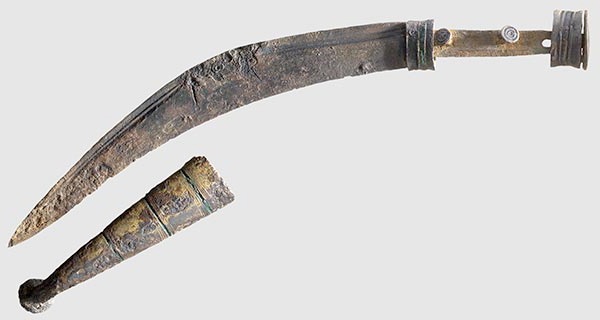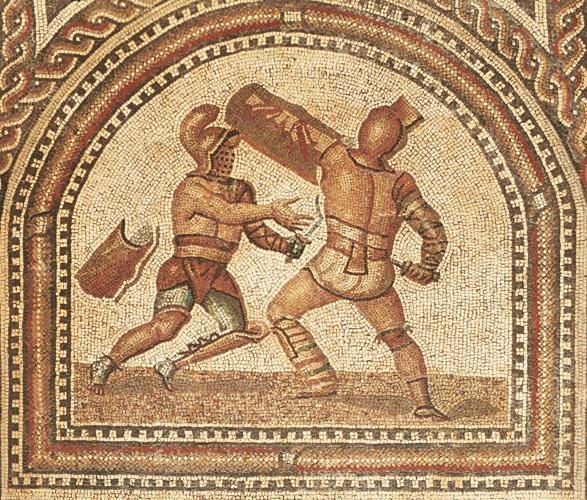| Author |
Message |
Aaron Morris

Location: pueblo,colorado Joined: 03 May 2009
Posts: 26
|
 Posted: Wed 03 Nov, 2010 2:04 pm Post subject: Sica curve Posted: Wed 03 Nov, 2010 2:04 pm Post subject: Sica curve |
 |
|
|
hello, I wanted to make a sica for a friend of mine, and I was wondering how they would put the curve in the blade, I know with most curved blades its just the warping as they quench it but with some of the sicas I've seen it looks more like a sharp bend, like they just took a gladius and bent it, so if anyone has any information it I'd appreciate it , thanks
|
|
  |
 |
|
Allen Jones
Location: NC, USA Joined: 10 Apr 2008
Posts: 18
|
 Posted: Wed 03 Nov, 2010 3:13 pm Post subject: Posted: Wed 03 Nov, 2010 3:13 pm Post subject: |
 |
|
I don't know how it was made originally but depending on how you want to make it you have a few different options. I think the simplest would be stock removal. Get a bar of steel the same width and thickness you want the blade to be at its base. Grind out the tapers and then heat it and bend it to the shape you like. Then grind the edges. You could start the edge grinding before the bend.
Also I would say that most European curved blades are not formed by the quenching process. When you forge a single edge sword it will curve more than you want. You are stretching one side which makes the curve. Now the sica is different. I agree that in some there is a sharp bend and they could have just bent it over the anvil while forging the edge.
Allen
|
|
  |
 |
|
Peter Johnsson
Industry Professional
|
 Posted: Thu 04 Nov, 2010 1:00 am Post subject: Posted: Thu 04 Nov, 2010 1:00 am Post subject: |
 |
|
The original Sica is a large single edged fighting knife. There are quite a few found, so we can know what they originally were like. They do not look very much like the Sica used by galdiators, at least if we are to go on the depictions in roman art of "Thraex" (the class of gladiators who were styled in semi mythological way to be Tracians warriors).
To my knowledge, no gladiator Sica has survived to our time, so we are left speculating as to their exact shape and construction from depictions in period art. They do seem to be double edged in some cases at least. The hilt looks like a roman adaption and the curvature is often very abrupt: very different from the original weapon.
The original Sica does of change over time and has its own typology. I have not studied them enough to present this. most were not all that large: most seem to have had blades in the 30-40 cm region or smaller. I get the impression that the thickness of the back was about 6 millimeter or so: they do not look like they have very thick backs, just sturdy. A few were a bit longer but they stand out. Then we have the Falx of course, but that is a different type of weapon with a (short) two handed haft.
To make a Sica you will have to forge it to shape with the edge on the inside of the curve. The cross section is triangular: no edge bevel and the sides of the blade are almost perfectly flat in most cases. You will have to plan the work and start forming a pre shape that has proper distal and profile taper that allows the correct triangular section to be drawn out. I imagine that you will have to keep correcting the curvature as you work.
Or you can take a broad and flat piece of steel, cut out the profile and grind the correct cross section.
Just remember that these weapons were not heavy choppers. They will feel rather light in the hand: they are not Kukri knives (at least not in general), but rather vicious slicers and stabbers.
The fuller/fullers is on one side only. Some have a hidden tang, some have full tang with scale handles. Grip is not very long: about 10 cm ( 4 "). It is common to see tubular reinforcements at each end of the grip. The scabbard often seems to have had a large and long chape, that covered almost half the length of the scabbard. I am not aware of any proof how the Sica was attached to the belt. Perhaps the scabbard was thrust behind the belt. Or there may have been some kind of belt attachment that was entirely organic and now lost.
An example of an original Sica from Herman Historica:
 Attachment: 31.92 KB Attachment: 31.92 KB

Sica of the 2nd C BC
 Attachment: 117.58 KB Attachment: 117.58 KB

The sica used by Thraex gladiators seems to have been influenced and morphed into a Gladius version of the weapon
|
|
   |
 |
|
|
You cannot post new topics in this forum
You cannot reply to topics in this forum
You cannot edit your posts in this forum
You cannot delete your posts in this forum
You cannot vote in polls in this forum
You cannot attach files in this forum
You can download files in this forum
|
All contents © Copyright 2003-2025 myArmoury.com — All rights reserved
Discussion forums powered by phpBB © The phpBB Group
Switch to the Basic Low-bandwidth Version of the forum
|

